Welcome to CounterTobacco.org’s “News and Research Roundup!” Each month we post a summary of the latest research, reports, and news stories on counteracting tobacco product sales and marketing at the point of sale (POS). Keeping up with what’s happening in the POS movement all across the country can help you choose policies and strategies that work best for your community. New research can help provide support for your work and evidence for the importance of the “War in the Store.” Have a story you don’t want us to miss? E-mail it to us!
New Research
Tobacco Retailer Density
- Socioeconomic disparities in vape shop density and proximity to public schools in the conterminous United States, 2018, Health Promotion Practice
- This study examined the distribution and density of vape shops in relation to minority and low-income youth’s places of schooling. Analysis of over 10,000 school districts and close to 8,000 vape shops found that school districts that had higher proportions of Asian and Black populations had a greater density of vape shops, as well as vape shops in closer proximity to schools. Since a greater density and closer proximity to vape shops could lead to increased exposure and access to vape products, these findings suggest that these minority populations may face disproportionate health impacts from vape product use. Learn more about policy options to reduce retailer density and proximity to schools.
Mint, Menthol and Other Flavors
- Characteristics and reach equity of policies restricting flavored tobacco product sales in the United States, Health Promotion Practice
- This study assessed the extent that bans on flavored tobacco products reached vulnerable populations that disproportionately use these products. Looking at the 189 flavor bans across the US as of December 2018, researchers determined that 6.3% of the US population was covered by a flavored tobacco
 product policy, which equates to fewer than 1 in 15 American citizens. Further analysis found that these policies provided equitable reach and protection to certain vulnerable sub-populations including young adults, women, Hispanics, African Americans, Asians, and those living below poverty but not to youth, American Indians/Alaska Natives, or Native Hawaiians/Pacific Islanders. In order to reduce inequities in these at-risk sub-populations, flavored tobacco restrictions should be expanded to have greater reach to cover communities with large proportions of these vulnerable groups. Learn more about health equity and POS tobacco control policy.
product policy, which equates to fewer than 1 in 15 American citizens. Further analysis found that these policies provided equitable reach and protection to certain vulnerable sub-populations including young adults, women, Hispanics, African Americans, Asians, and those living below poverty but not to youth, American Indians/Alaska Natives, or Native Hawaiians/Pacific Islanders. In order to reduce inequities in these at-risk sub-populations, flavored tobacco restrictions should be expanded to have greater reach to cover communities with large proportions of these vulnerable groups. Learn more about health equity and POS tobacco control policy. - News story: Menthol ban could increase health equity, UKNow
- This study assessed the extent that bans on flavored tobacco products reached vulnerable populations that disproportionately use these products. Looking at the 189 flavor bans across the US as of December 2018, researchers determined that 6.3% of the US population was covered by a flavored tobacco
E-Cigarettes
- Sources of youth access to JUUL vaping products in the United States, Addictive Behavior Reports
- Data from over 1,500 past 30-day Juul users, ages 13-17, found that close to 80% of youth did not buy their Juul products directly, but rather obtained them from a social source such as friend
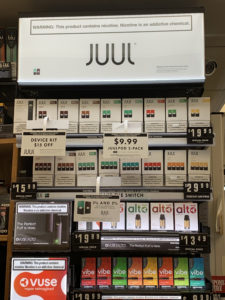 s or peers. 17% of youth respondents purchased Juul products for themselves with the most common place of purchase being a gas station or convenience store. Learn more about e-cigarettes like Juul at the point of sale.
s or peers. 17% of youth respondents purchased Juul products for themselves with the most common place of purchase being a gas station or convenience store. Learn more about e-cigarettes like Juul at the point of sale.
- Data from over 1,500 past 30-day Juul users, ages 13-17, found that close to 80% of youth did not buy their Juul products directly, but rather obtained them from a social source such as friend
- Socioeconomic and demographic status and perceived health risks of e-cigarette product contents among youth: Results from a national survey, Health Promotion Practice
- In this study, researchers analyzed data from a national sample of over 3,000 US youth, ages 13 to 18 years old, to determine the association between demographic factors and perceived health risks of e-cigarettes. They found that those who were never e-cigarette users had greater odds of perceiving health risks of nicotine and toxic ingredients in e-cigarettes than current users. Researchers also found that females and LGBTQ-identifying individuals were more likely to perceive health risks of e-cigarettes, whereas those who identified as low socioeconomic status, non-Hispanic blacks, and urban residents were less likely to perceive health risks of e-cigarettes. Additionally, youth with parents with lower educational attainment were less likely to perceive health risks of e-cigarettes. Learn more about health inequities in regard to tobacco products.
- News study: Teen perceptions about e-cigarette health risks vary by socioeconomics and personal demographics, Heart.Org
- Social influence in the uptake and use of electronic cigarettes: A systematic review, American Journal of Preventative Medicine
- This journal article reviewed 43 studies regarding the influence of social factors and norms on e-cigarette use and initiation. Consistent findings evidenced that exposure to advertising, including those disseminated through social media, increased intent to use and initiation of e-cigarettes. Various studies also evidenced how social norms, peers, family, and friends influence decision-making around e-cigarettes. Learn more about e-cigarettes at the point of sale and policies to restrict tobacco advertising at the point of sale.
- News story: ‘Consistent evidence’ social media pushes non-smokers into vaping: study, Brisbane Times
Point of Sale Advertising and Marketing
- Predictive validity of tobacco product advertising and retail availability, Tobacco Regulatory Science
- Using store audit data from tobacco retailers in New York City and New Jersey, researchers found that interior and exterior product advertising at the point of sale did not always align with product availability at retail stores. Stores that advertised cigarettes and cigars were more than 95% likely to carry these products at their retail locations; however, stores that advertised smokeless tobacco and ENDS were less likely to stock these products, and only 1 in 5 stores that had an electronic nicotine delivery system (ENDS) advertisement had the product for sale. Looking from a product availability standpoint, retailers that had cigarettes, smokeless tobacco and ENDS for sale posted similar amounts of advertisements for these products in the interior and on the exterior of their store; in contrast, stores that sold cigars were significantly less likely to advertise this product at their retail locations. Learn more about policies to restrict tobacco advertising at the point of sale.
- Tobacco advertisements: What message are they sending in African American communities?, Health
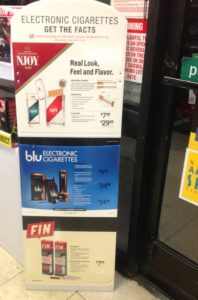 Promotion Practice
Promotion Practice
- Using Counter Tools’ Store Mapper, researchers evaluated messaging strategies used to promote tobacco products in retailer locations in predominately African American census tracks; they focused on three common and well-known strategies targeted at this population: (1) reassuring product use is safe despite the health risks, (2) redirecting attention from health risks to features of the products, and (3) emphasizing a sense of bravery in use despite the associated health risks. Through analysis of 165 advertisements, researchers determined that ads for cigarettes and ‘nonlarge cigars’ tended more often to redirect attention from the health risks of the product by amplifying features of the product, whereas e-cigarette advertisements more frequently focused on reassuring use of the product despite the associated health risks. The researchers suggest that more stringent restrictions on these types of advertisements in these communities could have the potential to reduce tobacco-related health disparities. Learn more about policies to restrict tobacco advertising at the point of sale.
- Retail tobacco marketing in rural versus nonrural counties: Product availability, discounts, and prices, Health Promotion Practice
- Using data from 1,276 licensed tobacco retailers in California in 2017, researchers examined differences in availability and prices of tobacco products between stores categorized at the county and tract levels as either rural or nonrural. In this study, rural stores were 2.1 times more likely to sell chewing tobacco and 2.5 times more likely to sell roll-your-own tobacco, compared to the nonrural stores. As well, money went further in rural stores, with rural stores selling larger packs of cigarillos for less than $1 and also selling the cheapest pack of cigarettes for an average of $0.21 less than the nonrural stores. In rural stores, discounts on chewing tobacco were 1.81 times more likely to be advertised than in nonrural stores;
 however, at least one popular brand of chewing tobacco was sold at a significantly higher price in the rural locations. This study helps depict the disparities in product prices and advertising based on rurality. Learn more about rural tobacco use and the point of sale.
however, at least one popular brand of chewing tobacco was sold at a significantly higher price in the rural locations. This study helps depict the disparities in product prices and advertising based on rurality. Learn more about rural tobacco use and the point of sale.
- Using data from 1,276 licensed tobacco retailers in California in 2017, researchers examined differences in availability and prices of tobacco products between stores categorized at the county and tract levels as either rural or nonrural. In this study, rural stores were 2.1 times more likely to sell chewing tobacco and 2.5 times more likely to sell roll-your-own tobacco, compared to the nonrural stores. As well, money went further in rural stores, with rural stores selling larger packs of cigarillos for less than $1 and also selling the cheapest pack of cigarettes for an average of $0.21 less than the nonrural stores. In rural stores, discounts on chewing tobacco were 1.81 times more likely to be advertised than in nonrural stores;
- Cigarette and e-cigarette retail marketing on and near California Tribal Lands, Health Promotion Practice
- Given American Indian/Alaskan Natives have the highest prevalence of smoking of any racial/ethnic group in the United States, this study assessed the availability of cigarettes and e-cigarettes and the accompanying advertising and promotional tactics of these products on and within a 1-mile radius of California Tribal lands. Store observations of nearly 100 stores determined that nearly all stores, both on and near Tribal lands, offered menthol cigarettes. On Tribal lands, a quarter of stores were located in casinos and 40% of stores offered a Tribal member discount. Interestingly, stores that were within a 1 mile radius, not directly on Tribal lands, sold significantly more e-cigarettes (70% compared to 38%), including of the flavored variety, and also more commonly offered price promotions for cigarettes (47% of stores vs. 23% of stores). Learn more about Native American populations and point of sale tobacco and promotions at the point of sale.
Tobacco 21
- Cigarette and cigar sales in Hawaii before and after implementation of a Tobacco 21 law, Tobacco Control
- This study assessed differences in sales shares between mainland US, California (which implemented Tobacco 21 with a military exemption in June 2016), and Hawaii (which implemented Tobacco 21 with no exemptions in January 2016). In Hawaii, once Tobacco 21 was implemented, the average monthly unit sales of cigarettes, large cigars, and cigarillos and the menthol market share decreased significantly. These findings highlight the effect Tobacco 21 policies may have in reducing sales of commonly used tobacco products. Learn more about Tobacco 21 policies.
- News story: CDC reports confirm benefits of raising tobacco age to 21, AAP News
- Onset of regular smoking before age 21 and subsequent nicotine dependence and cessation behavior among US adult smokers, Preventing Chronic Disease
- Analysis of data from the 2014-2015 Tobacco Use Supplement to the Current Population Survey found that those who started smoking before the age of 18 were 2.15 times as likely to become nicotine dependent in their lives, compared to those who started smoking at age 21 or older; furthermore, those who started smoking between the ages of 18 and 20 were 1.25 times as likely to become nicotine dependent in their lives than those who started smoking at age 21 or older. Additionally, those who initiated smoking before age 21 had lesser odds of quit attempts and intention to quit than those who initiated smoking at age 21 or older. These findings highlight the important of Tobacco 21 policies on reducing youth use, which in turn would likely reduce the odds of nicotine dependence. Learn more about Tobacco 21 policies.
International
- Cohort effects of tobacco control policy: Evidence to support a tobacco-free norm through smoke-free policy, Tobacco Control
- Using cross-sectional survey data from South Korean youth, ages 12 to 18, this study assessed the effects of a ban on smoking in public places and an increase in price on cigarettes on adolescent smoking behaviors over time. While the ban on smoking in public places was significantly negatively associated with prevalence of smoking in both young males and females, an immediate decrease in smoking prevalence was only associated with an increase in cigarette prices in female youth. Learn more about increasing tobacco prices through non-tax approaches.
Other
- Assurances of voluntary compliance: A regulatory mechanism to reduce youth access to e-cigarettes and limit retail tobacco marketing, American Journal of Public Health
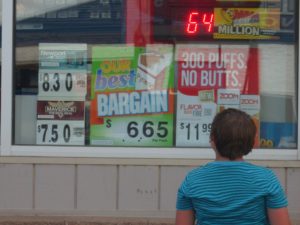
- Researchers evaluated the extent that assurances of voluntary compliance (AVCs), or legally binding voluntary agreements between retail corporations and state attorneys, affected underage e-cigarette sales and tobacco marketing violations. By comparing corporate-owned stores that signed AVCs to franchise stores that did not sign AVCs, they found that franchise stores without AVCs were 3.4 times more likely to violate ID requests to check age and 2.7 times more likely to sell e-cigarettes to underage decoys than the corporate-owned stores with AVCs. In stores both with and without AVCs, advertising violations were common. These findings suggest that establishing AVCs could assist in reducing youth access to e-cigarette products and advertising. Learn more about AVCs.
- Cigarette prices in rural and urban Ohio: Effects of census tract demographics, Health Promotion Practice
- Through a sample of over 100 urban and 100 rural tobacco retailers in Ohio, this study compared the intersection of rurality, socioeconomic status, and race in regard to prices of brand-name and low-cost cigarettes. Analysis evidenced that the lowest prices of ‘cheap cigarettes’ were on average sold in rural areas with the highest percentage of residents living below poverty level – a finding that was not mimicked in urban Ohio. On the other hand, prices for brand-name cigarettes like Marlboro Reds increased, in both rural and urban areas, when income increased and the percentage of White residents increased. These findings show that cheap cigarettes are cheapest in low-income rural areas, while brand-name cigarettes are more expensive in areas with higher income and more White people. Learn more about disparities in point of sale.
- Community-led action to reduce menthol cigarette use in the African American community, Health Promotion Practice
- This qualitative study examined the successes, challenges, and lessons learned stemming from a partnership established between a Minnesota county health department and an African American community-based organization to educate and encourage community advocacy for a menthol-focused tobacco control policy. The policy, which restricted the sale of menthol tobacco products to adult-only stores, was ultimately adopted in three major Minnesota cities. While the findings are extensive, two major highlights were the importance of youth engagement and the benefits of using community assessment data to inform policy decisions. For any localities looking to develop or advocate for tobacco control policies, this qualitative research provides important lessons on taking a community-driven approach. Learn more about youth and community engagement and store assessments.
- Assessing the potential impact of cigarette packs designed for lesbian, gay, bisexual and transgender adults: A randomized experiment to inform U.S. regulation, 2018, Health Promotion Practice
- This randomized study of approximately 950 participants, half of which were sexual and gender minorities, assessed the impact of targeted marketing on cognitive, affective, and behavioral intention of participants to use tobacco products. To determine these outcomes, participants viewed a cigarette pack that either had no targeting, subtle targeting (some design elements associated with sexual and gender minority populations), or a highly targeted rainbow ‘pride edition’. Sexual and gender minority participants rated the pride addition cigarette pack, in comparison to the nontargeted pack, more positively than cisgender and straight participants. As well, sexual and gender minority participants ranked the pride pack as more appealing and noticeable than cisgender and straight participants did. These findings suggest that targeted marketing by the industry to this vulnerable community may foster positive attitudes toward these harmful tobacco products. Learn more about health equity and point of sale tobacco control policy.
- Support for e-cigarette and tobacco control policies among parents of adolescents, Nicotine & Tobacco Research
- Data from a nationally representative sample of parents of middle and high school students found wide support for tobacco policies aimed at protecting adolescents. More than 90% of participating parents supported restrictions on marketing e-cigarettes to youth and 75% supported a ban on flavored e-cigarettes. As well, more than 80% of parents supported raising the minimum legal sale age to 21, reducing tobacco retailer density near schools, and removing tobacco products from view in stores where youth shop. Responses were similar between parents who currently use tobacco products and those who do not. These findings show the broad support of parents for stronger tobacco control measures. Learn more about various tobacco policy solutions.
- Interest in illicit purchase of cigarettes under a very low nicotine content product standard, Nicotine & Tobacco Research
- Researchers assigned a convenience sample of approximately 1,700 US adult smokers to either an experimental arm in which participants read information about a hypothetical new standard in which 95% of nicotine in cigarettes was removed and stores could only sell these very low nicotine content (VLNC) products or a control arm in which participants were given no information. Participants who were provided information on the VLNC standard were more likely to be ‘very’ or ‘extremely’ interested in purchasing illicit, full-nicotine content cigarettes from a website, street vendor, or store on an Indian reservation than those in the control group who received no information. These findings suggest that, if VLNC standards are implemented, certain proactive policy measures and public education campaigns should be rolled out as well. Learn more about policies restricting product availability.
- Trends in e-cigarette, cigarette, cigar, and smokeless tobacco use among US adolescent cohorts, 2014-2018, American Journal of Public Health
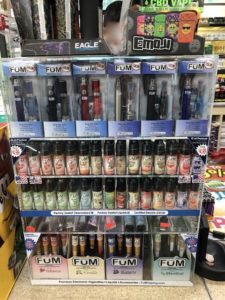
- Analysis of data from five cohorts of the National Youth Tobacco Survey from 2014-2018 found that, in recent years, youth are initiating use of e-cigarettes at a younger age. In 2014, 8.8% of respondents reported initiating e-cigarette use at age 14 or younger, while in 2019, 28.6% of respondents reported initiating e-cigarette use at age 14 or younger. No significant changes were found in ages of initiation for cigarettes, cigars, or smokeless tobacco products. Learn more about industry tactics to target youth.
- News story: Number of youth who started vaping at 14 or before has tripled, EurekAlert!
- Age of tobacco use initiation and association with current use and nicotine dependence among US middle and high school students, 2014-2016, Tobacco Control
- This study analyzed data from the National Youth Tobacco Survey to assess age of initiation of non-cigarette tobacco products and the relationship between use of these products, nicotine dependence and progression to established use. Data demonstrated that the median age for first use of cigarettes was the youngest with a median age of 12.6, followed by smokeless tobacco (median age 13.4), cigars (median age 13.8), hookah (median age 14.1), and e-cigarettes (median age 14.1). They also found that initiation of one of these tobacco products before the age of 13, compared to at an older age, was associated with increased odds of established daily use of the product and nicotine dependence. Learn more about industry tactics to target youth.
Industry News
- Why tobacco industry giants backed raising the minimum age of purchase, NPR
- Vaping industry offers academic scholarships to high school kids, Reuters
- Premium cigar makers could catch a break from the FDA as White House applies pressure, CNBC
- 22nd Century Group appoints new director and new chairman, GlobeNewswire
- Altria-Juul deal is stuck in antitrust review, The Wall Street Journal
- Tobacco industry targets Vermont’s proposed ban on menthol products, VT Digger
- NJOY to stop selling fruit-flavored e-cigarettes, CSP
POS Policy in the Media
E-Cigarettes
National
- Most young vapers aren’t using e-cigs to quit smoking: Survey, US News & World Report
- Facebook and Instagram will ban influencers from promoting e-cigs, CBS News
- D.A plans to ban most e-cigarette flavors but menthol, The New York Times
- FDA finalizes enforcement policy on unauthorized flavored cartridge-based e-cigarettes that appeal to children, including fruit and mint, FDA
- FDA to consider restricting menthol vape products if teens begin using them, officials say, CNBC
- Vaping: Move to ban some flavors only 1st step in addiction fight, American Medical Association
- The great vape escape: Trump fails to follow through on a promised flavored liquid ban, New York Daily News
- Vapes without FDA approval could stay on sale long past deadline, Bloomberg Law
- Senators criticize e-cigarette, e-liquid policy, CBS 19 News
State-wide
- Massachusetts AG Healy sues sales of flavored vapes, CBS Boston
- [NY] Cuomo plan bans flavored nicotine vape products, buying e-cigs online, Newsday

- Rhode Island considers permanent flavored vape products ban, CBS Boston
- Georgia lawmakers propose vape ban, 41NBC/WMGT
- Utah proposes new vaping rules that kick flavored juices and related products out of certain stores, Fox13
- Hawaii lawmakers pushing for a crackdown on vaping, Honolulu Civil Beat
- 5 online retailers banned from selling flavored vapes in Mass., NBC Boston
- Judge blocks NY ban on flavored vaping products, Associated Press
- [CA] Newsom proposes new vaping tax based on product’s nicotine content, Los Angeles Times
- New Jersey law bans sale of flavored vaping products, Associated Press
- [WA] Inslee pitches permanent ban on flavored vape products, Patch
Local
- D. C. Council hears concerns over e-cigarette access, The Washington Times
- [MN] Missoula health officials to enforce flavored vaping products ban, KPAX
- [NJ] Piscataway outlaws e-cigarette/vape sales in nearly entire town, Patch
- [CA] Council votes to ban all e-cigarette sales in San Luis Obispo, Mustang News
Tobacco 21
National
- Federal legal age to buy tobacco products officially raised to 21, Time
- Stores enforce new tobacco age restriction after FDA announces ‘immediate’ implementation, WJHL
- Sudden enforcement of age 21 tobacco restrictions catches retailers, customers by surprise, Winston-Salem Journal
- Federal Tobacco 21 law axes exemption in state law for military service members, Meadville Tribune
State-wide
- New Washington state laws to take effect on Jan. 1, 2020, My Northwest
- Vaping, smoking age in Nebraska increases to 19 on Jan. 1, with federal age of 21 by s
 ummer, Omaha World-Herald
ummer, Omaha World-Herald - Indiana may toughen retailer penalties with 21 smoking age, Journal Review
- New Hampshire Senate raises age to buy tobacco products, WCAX
- [IN] Bill advances to raise age to buy tobacco products, The Statehouse File
- [OK] McCortney bill would raise minimum age on tobacco to 21, Enid News & Eagle
Local
- [MN] Wright County tobacco 21 ordinance to take effect in 2020, Patch
- [NY] Saint Regis Mohawk Tribal Council passes resolution setting 21 as legal age for buying vaping products, North Country Now
- [CO] Pitkin County to raise tobacco age despite federal action, Aspen Times
- [MN] Carlton County raises legal age to buy tobacco to 21, Pine Journal
- [CO] Monte Vista City Council passes ordinance 900, The Monte Vista Journal
- [St. Joseph, MO] Update: City raises age to buy tobacco products to 21, KQ2
- [IL] Madison County bans vaping for minors, Advantage News
Menthol and Other Flavored Tobacco Products
- Sacramento will ban sales of flavored tobacco on Jan. 1. Here’s what you need to know, The Sacramento Bee
- [CA] Menlo Park ban on flavored tobacco, vaping devices effective Jan. 17, The Almanac
- [CA] Pacific Grove bans flavored tobacco, Monterey Herald
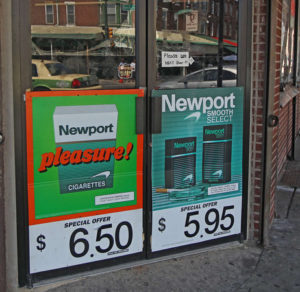 California vaping bill would ban all flavored tobacco sales in stores, Los Angeles Times
California vaping bill would ban all flavored tobacco sales in stores, Los Angeles Times- [CA] Oroville will hold public hearing for possible ban of all flavored tobacco sales, Enterprise-Record
- Delegates propose raising cigarette tax, banning sales of flavored tobacco products in Virginia, WRIC
- Menthol ban gains momentum among black lawmakers, Politico
- New York legislators push ban of e-cigarettes and flavored tobacco, Hudson Valley 360
- [San Diego County, CA] County leaders ban vaping, flavored smoking product sales, NBC San Diego
- [CA] Oroville bans flavored tobacco sales and discusses districting, Oroville Mercury-Register
- Vermont bill would ban flavored tobacco, vape products, NBC5
- [CA] Imperial Beach bans flavored tobacco products, The San Diego Union-Tribune
Tobacco Retailer Licensing
- Auburn’s new tobacco laws begin Jan.1, Gold Country Media
- With new year, new laws to take effect in Summit County and Colorado, Summit Daily
- [Clatsop County, OR] County commissioners approve tobacco ordinance, The Astorian
- [CO] Boulder gives final approval to tobacco licensing program, closing flavored vapor ban loophole, Boulder Daily Camera
- [Alameda County, CA] Supervisor Wilma Chan: County adopts tobacco retail license ordinance, Post News Group
Other
- [MN] Missoula County, state take different roles in enforcing new tobacco, vaping restrictions, Missoula Current
- Brown leads Dem Senators in introducing comprehensive legislation to address youth tobacco crisis, Senate.gov
- [Columbia, MO] City council adopts pilot program to track tobacco product marketing, ABC 17 News
- [NJ] Diegnan, Codey bill to ban tobacco and vaping promotions now law, Insider NJ
Find more stories in last month’s News and Research Roundup.
Know of a story that we missed? Email us, and we’ll be sure to include it in next month’s roundup!


